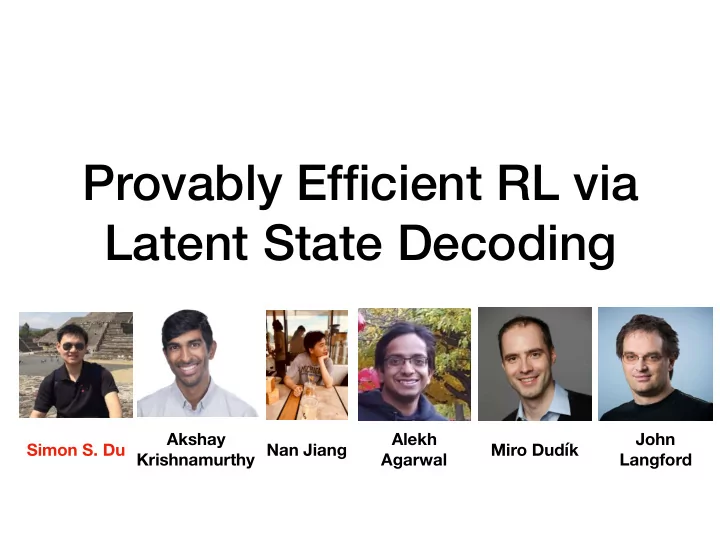

Provably Efficient RL via Latent State Decoding Akshay Alekh John Simon S. Du Krishnamurthy Nan Jiang Miro Dudík Agarwal Langford
RL theory vs practice
RL theory vs practice Theory Simple tabular environments No generalization
RL theory vs practice Theory Practice Simple tabular environments Complex rich-observation environments No generalization Generalization via function approximation
RL theory vs practice Theory Practice Simple tabular environments Complex rich-observation environments No generalization Generalization via function approximation Can we design provably sample-e ffi cient RL algorithms for rich observation environments?
Block MDPs A structured model for rich observation RL
Block MDPs Context x A structured model for rich observation RL • Agent only observes rich context (visual signal)
Block MDPs State s Context x A structured model for rich observation RL • Agent only observes rich context (visual signal) • Environment summarized by small hidden state space (agent location)
Block MDPs State s Context x (Left) Action a A structured model for rich observation RL • Agent only observes rich context (visual signal) • Environment summarized by small hidden state space (agent location)
Block MDPs For H steps State s State s Context x Context x (Left) Action a Action a A structured model for rich observation RL • Agent only observes rich context (visual signal) • Environment summarized by small hidden state space (agent location)
Block MDPs For H steps State s State s Context x Context x (Left) Action a Action a A structured model for rich observation RL • Agent only observes rich context (visual signal) • Environment summarized by small hidden state space (agent location) • State can be decoded from observation
Objective: Find a Decoder
Objective: Find a Decoder Idea: Find a function that decodes f( ) = hidden states from contexts. context state
Objective: Find a Decoder Idea: Find a function that decodes f( ) = hidden states from contexts. context state Reduce to a tabular problem
Objective: Find a Decoder Idea: Find a function that decodes f( ) = hidden states from contexts. context state Reduce to a tabular problem Main Challenge: There is no label (we cannot observe hidden states).
Approach
Approach Our Approach: Learn a function that predicts the conditional probability of (previous state, action) pairs from f( ) = contexts. (assume access a regression oracle to s1,a1 s1,a2 s2,a1 s2,a2 context learn this function) State at level h: s1, s2 Actions: a1, a2
Approach Our Approach: Learn a function that predicts the conditional probability of (previous state, action) pairs from f( ) = contexts. (assume access a regression oracle to s1,a1 s1,a2 s2,a1 s2,a2 context learn this function) State at level h: s1, s2 Actions: a1, a2 Di ff erent conditional probabilities correspond to di ff erent states s1,a1 s1,a2 s2,a1 s2,a2 s1,a1 s1,a2 s2,a1 s2,a2 State at level h+1: s3 s4
Approach Our Approach: Learn a function that predicts the conditional probability of (previous state, action) pairs from f( ) = contexts. (assume access a regression oracle to s1,a1 s1,a2 s2,a1 s2,a2 context learn this function) State at level h: s1, s2 Actions: a1, a2 Di ff erent conditional probabilities correspond to di ff erent states s1,a1 s1,a2 s2,a1 s2,a2 s1,a1 s1,a2 s2,a1 s2,a2 State at level h+1: s3 s4 State classification
Guarantees Theorem: Our algorithm can find a near-optimal decoder with poly(M,K,H) samples in polynomial time, with H calls to supervised learning black box.
Guarantees Theorem: Our algorithm can find a near-optimal decoder with poly(M,K,H) samples in polynomial time, with H calls to supervised learning black box. M = Number of hidden states, K = Number of actions, H = Time horizon
Guarantees Statistical e ffi ciency Theorem: Our algorithm can find a near-optimal decoder with poly(M,K,H) samples in polynomial time, with H calls to supervised learning black box. M = Number of hidden states, K = Number of actions, H = Time horizon
Guarantees Statistical e ffi ciency Theorem: Our algorithm can find a near-optimal decoder with poly(M,K,H) samples in polynomial time, with H calls to supervised learning black box. M = Number of hidden states, K = Number of actions, H = Time horizon Computational e ffi ciency
Guarantees Statistical e ffi ciency Theorem: Our algorithm can find a near-optimal decoder with poly(M,K,H) samples in polynomial time, with H calls to supervised learning black box. M = Number of hidden states, K = Number of actions, H = Time horizon Computational e ffi ciency Rich observations
Guarantees Statistical e ffi ciency Theorem: Our algorithm can find a near-optimal decoder with poly(M,K,H) samples in polynomial time, with H calls to supervised learning black box. M = Number of hidden states, K = Number of actions, H = Time horizon Computational e ffi ciency Rich observations Assumptions • Supervised learner expressive enough • Latent states reachable and identifiable
Algorithm details and experiments @ Poster #208
Recommend
More recommend